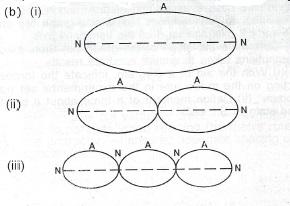a) (i) Illustrate, using a ray diagram, how an image can be formed by a convex mirror.
(ii) State one advantage rid one disadvantage of using a convex mirror as a iving mirror.
(iii) Explain the action of a compound microscope.
(b) Illustrate using labelled diagrams only, sonometer wire of length I, vibrating at its fundamental (ii) first overtone (iii) second overtone
(c) A tuning fork vibrating at a frequency of 512 Hz is held over the top of a jar filled with water and fitted with a tap at the buttom. If the jar is 60 cm tall and the speed of sound is 350 ms\(^{-1}\), determine the possible resonance position(s).
(a)(i)

(ii) Advantages of using a convex mirror as driving mirror.
– It has wide field of view
– Image is always erect.
Disadvantages;
– Image is always smaller than the object
– It gives a false impression of the distance as image seems further away.
(iii) The objective lens forms the image of an object placed beyond its focal length within the focal length of eye piece. This image is real inverted and magnified. This image serves as object to the eye piece which functions as a simple microscope to form a final virtual and magnified image.

(c) \(\lambda = \frac{v}{f} = \frac{350}{512} = 0.68m\)
1st resonance position = \(\frac{\lambda}{f} = \frac{0.68}{4} = 0.17m\)
2nd resonance position = \frac{3\lambda}{4} \frac{3 \times 0.68}{4} = 0.51m\)
3rd resonance position = \(\frac{5\lambda}{4} = \frac{5 \times 0.85}{4} = 0.85m\)
Since 0.85m is greater than the length of the jar (0.6m), therefore only the first and second resonance positions are possible.
Contributions ({{ comment_count }})
Please wait...
Modal title
Report
Block User
{{ feedback_modal_data.title }}